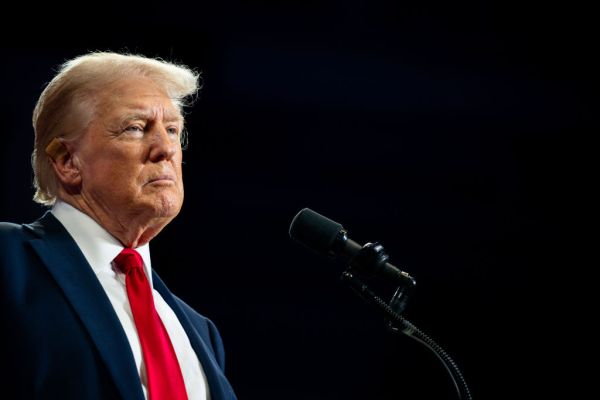A federal jury awarded E. Jean Carroll more than $80 million last month in her defamation lawsuit against former President Donald Trump. The path to that verdict was anything but straightforward, thanks to claims presented in two separate but related lawsuits.
The strikingly different verdicts returned by the two juries raise a question: Will the second, $83 million verdict be reduced?
What prompted Carroll’s first lawsuit?
The basis for Carroll’s initial lawsuit was that in late 1995 or early 1996, Carroll, then a 52-year-old journalist, TV commentator, and advice columnist for Elle magazine, encountered Donald J. Trump, then a 49-year-old businessman, in the Bergdorf Goodman department store in New York City. After some banter about shopping advice from the “advice lady” and which one of them would try on an item of ladies’ lingerie, Trump suddenly pushed Carroll against a wall in an unoccupied dressing room and forcibly sexually assaulted her, penetrating her vagina with both a finger and his penis, she later testified.
Carroll did not go public with her accusations until June 2019, when New York magazine published an excerpt from her then-upcoming book, What Do We Need Men For?, that featured a detailed account of the assault. Trump, who was by then more than halfway through his term as president, responded later the same day and in the ensuing days, publicly denying that he had ever even met Carroll, and charging that she had fabricated the story to increase book sales and advance a political agenda.
In November 2019, Carroll sued Trump in state court in New York. The suit, referred to as Carroll I, sought damages for defamation only, because a suit for assault and battery had long been barred by the applicable statute of limitations. The following September, while Donald Trump was still president, the Department of Justice asked to “remove” the case from state court to the United States District for the Southern District of New York, asserting that it was really a suit against the United States since speaking to the public and the media on matters of public concern were within the scope of Trump’s employment as a government official.
When a case is removed from state to federal court, there is a change of courthouses only, not the applicable law. Accordingly, when Carroll I was eventually assigned to Senior Judge Lewis Kaplan, he based his later rulings in the case on New York rather than federal law.
What led to Carroll’s second lawsuit?
Litigation over who was the proper defendant (as well as whether Donald Trump could claim immunity from the suit) continued well into 2023.
Meanwhile, in October 2022, Trump—by this time out of the White House and back to being a private citizen—published a lengthy post on Truth Social doubling down on his verbal attacks on Carroll. He referred to Carroll I as the “Ms. Bergdorf Goodman case,” and said it was “a complete con job,” a hoax, and a lie. He tripled down by saying in a deposition that Carroll was a “nut job,” and again denying that he had met her or even knew who she was before the first suit was filed.
On November 24, 2022, Carroll filed her second defamation suit, referred to as Carroll II, in federal court. Suing in federal court at the outset was appropriate this time, because Carroll was still a New Yorker, while defendant Trump had become a resident of Florida. In such a “diversity of citizenship” case, New York state law rather than federal law would again apply. The second Carroll v. Trump case was also assigned to Judge Kaplan.
Because of a recently enacted New York statute, the Adult Survivors Act (ASA), there was a major substantive difference between Carroll I and Carroll II. The ASA, signed into law by Gov. Kathy Hochul in 2022, created a one-year “lookback” window that allowed plaintiffs to file civil claims for sexual assault for which the statute of limitations had already expired. In her second lawsuit, therefore, Carroll was able to sue Trump for both the 2022 defamation and the 1996 sexual assault, in federal court but under New York law.
What was the verdict in Carroll II?
With Carroll I still tied up in satellite litigation, Carroll II was tried first, beginning on April 25, 2023. On May 9, 2023, after three hours of deliberation, the anonymous nine-person jury delivered a unanimous “special verdict”—written answers to a series of narrow and logically sequenced questions that Judge Kaplan had posed. These answers showed that the jury had found at least these facts: 1) During the Bergdorf Goodman incident, Trump penetrated Carroll’s vagina with one or more of his fingers; 2) Carroll did not consent to this penetration; and 3) Trump’s assertions in 2022 that Carroll had fabricated her entire account was false, and Trump knew it was false.
Although the jury had not been convinced that Trump had penetrated Carroll with his penis (which would constitute rape under New York law), its special verdict meant that she had prevailed on both of her substantive claims—sexual abuse and defamation. The jury then answered another set of questions to explain how it reached its damages award—a total of $5 million, which included both compensatory damages and punitive damages, for both the assault and the defamation. That verdict is on appeal, but it cast a large shadow on the proceedings of Carroll I when it came to trial last month.
Why was the second verdict in Carroll I so large?
Trial in the original defamation-only case was finally set to begin in mid-January 2024. In September 2023, however, Judge Kaplan ruled that the jury in Carroll II had conclusively determined all the issues in Carroll I except the amount of the damages that Trump would owe. Under the doctrine of collateral estoppel, which is essentially a “you don’t get two bites at the same apple” rule, Trump would be precluded from arguing that he did not sexually assault Carroll in the dressing room at Bergdorf Goodman’s, and he (therefore) would also be precluded from arguing that he told the truth when he repeatedly insisted that she had fabricated the whole incident.
Although this meant that the jury would go about its work with Trump’s liability already established and not subject to challenge, that liability was limited to the defamation only, not the sexual attack (which formed no part of the claims in Carroll I.) Moreover, to avoid “double-dipping” by Carroll, the jury would not be allowed to consider any injury that Trump’s 2022 defamatory statements might have caused.
This made the jury’s eventual January 26 verdict all the more astonishing. Instructed to consider only the defamation and not the sexual assault, the jury awarded E. Jean Carroll $7.3 million for the emotional harm and $11 million for injury to her reputation (including monies needed to mount a public relations campaign to restore it). Punitive damages were set at $65 million—again pursuant to instructions prohibiting consideration of the sexual assault.
Will the verdict stand?
Trump has indicated he will appeal the eye-popping numbers. He will likely argue that more than $18 million in compensatory damages for defamation only was excessive and the result of passion and prejudice. After all, he could say, the first jury awarded only a total of $5 million for compensatory damages and punitive damages, for both defamation and the sexual assault. He could also assert that the jurors could not have reached that compensatory award without considering the sexual assault and thus violating the court’s instructions.
Regarding punitive damages, Trump would probably argue that $65 million is so far out of the norm that it can only be explained by an unreasonable urge to “soak the rich.” He will also point to a line of Supreme Court cases holding that “grossly excessive” punitive damages can violate the Due Process Clause of the federal Constitution as well.
The upshot of all this will likely be a remittitur by Judge Kaplan, which is a reduction in the jury awards to the highest amount that would not be excessive. That would give Carroll a choice: accept the Kaplan’s reduction in awards or face a new trial (which would again be limited to a determination of damages only). If Carroll accepted the reduced awards, Trump could still appeal, but his appeal would be correspondingly weaker.
Trial court judges are given a great deal of discretion in crafting remittiturs, because they heard every word that the jurors heard during the trial and watched each witness’s demeanor during testimony. In this case, Kaplan will probably consider some combination of the following factors.
First, with respect to compensatory damages, it might be said that being defamed from the bully pulpit of the White House (as in Carroll I) is more fraught than being defamed by a prominent and controversial private citizen (as in Carroll II). That could justify a higher award in the former case, but perhaps not as high as the jury’s award. Second, with respect to punitive damages, it might be said that although defamation–the only claim at issue in Carroll I–is not as reprehensible as sexual assault, abusing the powers of the presidency to target a private citizen is sufficiently egregious to merit a higher award than in the case of a wealthy private citizen, although again not without limits. Finally, in setting an award that will send both a punitive and a prophylactic message—which is the mission of punitive damages, after all—Kaplan may take into account Trump’s misconduct in the presence of the jury, when he disrupted Carroll’s testimony by audibly objecting and protesting from his seat in the courtroom.








Please note that we at The Dispatch hold ourselves, our work, and our commenters to a higher standard than other places on the internet. We welcome comments that foster genuine debate or discussion—including comments critical of us or our work—but responses that include ad hominem attacks on fellow Dispatch members or are intended to stoke fear and anger may be moderated.